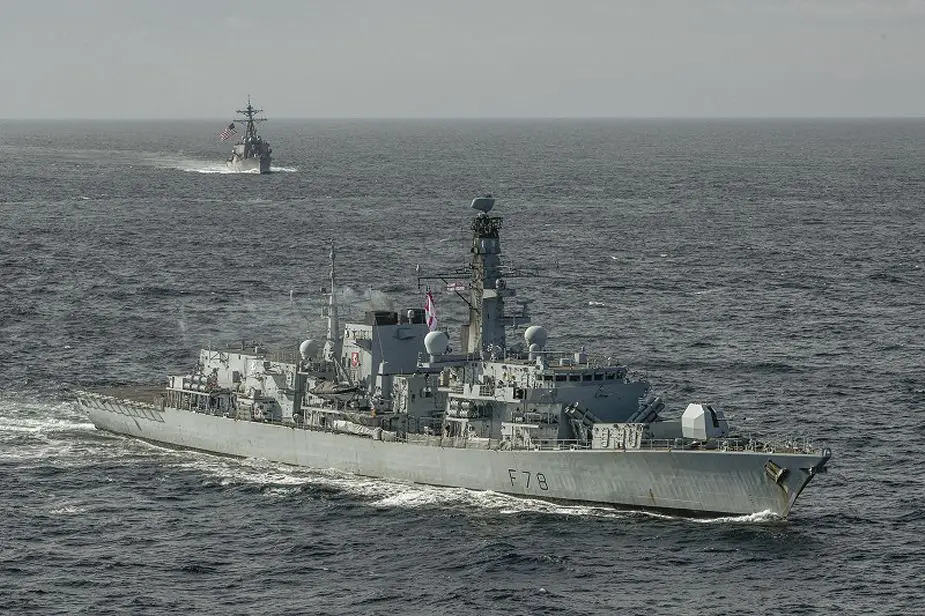Breaking news
British Royal Navy HMS Kent Type 23 Duke class frigate concludes operations in the Arctic Circle.
British Royal Navy HMS Kent, a Type 23 Duke class frigate has left the Barents Sea on May 8, 2020, after seven days of cold-weather operations in the icy waters of the Arctic Circle. The ship has been working as part of a combined US and UK task group, practising further integration with our allies and proving her ability to operate at sea in sub-zero temperatures hundreds of miles inside the Arctic Circle.
Follow Navy Recognition on Google News at this link
 British Royal Navy HMS Kent Type 23 Duke class frigate. (Picture source British Navy)
British Royal Navy HMS Kent Type 23 Duke class frigate. (Picture source British Navy)
More than 1,200 military personnel from the UK and US have been involved – conducting key training in support of the UK’s Defence, while the UK Armed Forces continue support to the NHS and others in the fight against COVID-19.
Rear Admiral Simon Asquith, the Royal Navy's Commander Operations, said: “While sailors and marines in the UK support the national effort against COVID-19, the ship's company of HMS Kent are hard at work ensuring that the Royal Navy remains capable of operating in the most challenging environments fundamental to the UK’s vital interests.
The ship has been working alongside destroyers USS Donald Cook, USS Porter and the USS Roosevelt as well as fast combat support ship USNS Supply.
In the last 12 months, HMS Kent has operated around the world and seen the full spectrum of challenging conditions in the past year, having operated in the high temperatures of the Gulf last year before taking up her tasking in the north Atlantic and high north.
The ship’s activity plays a key role in the defence of the United Kingdom. The Royal Navy continues to conduct essential operations around the world ensuring the defence of the UK’s global interests now and in the future.
HMS Kent is a Type 23 Duke class frigate of the British Royal Navy, and the twelfth ship to bear the name, although technically she is named after the dukedom rather than the county. The Type 23 frigate or Duke class is a class of frigates built for the United Kingdom's Royal Navy.
The armament of the Type 23 frigate includes Harpoon anti-ship missile capable of destroying enemy ships far beyond the horizon. Fitted to all Type 23 Frigates the Harpoon is a sophisticated anti-ship missile capable of striking targets more than 80 miles away. Harpoon uses a combination of inertial guidance and active radar homing to attack its prey. Cruising at Mach 0.9 and carrying a large high explosive warhead it is powered by a lightweight turbojet but is accelerated at launch by a booster rocket.
The front deck of Type 23 is fitted with a BAE 4.5 inch Mk 8 naval gun. The gun can fire up to two dozen high explosive shells, per minute, weighing more than 40 kg (80lbs) at targets more than a dozen miles away - and nearly 18 miles if special extended-range shells are used. The main purpose of the gun is Naval Gunfire Support – artillery bombardment of shore targets. In this role, the gun is capable of firing the equivalent of a six-gun shore battery.
The Type 23 is also armed with 32-cell Sea Wolf GWS.26 VLS (vertical launching system) canisters. Seawolf is the shield of Britain's frigate fleet against air attack. In service for more than 30 years, it has proven itself in battle and remains a potent weapon to this day. Seawolf is intended to defend an individual ship rather than a task group. It is fired from a vertical silo and guided on to its target by a tracking system on the ship and can track and destroy a target the size of a cricket ball traveling at three times the speed of sound.
For close protection, Type 23 is armed with small-caliber weapons such as SA80, General Purpose Machine Gun and 9mm guns for use against both surface and airborne targets. Unlike the majority of the ship's weapons systems, these guns are not radar and computer-controlled, but aimed and fired by the upper deck gun crews. The weapons range in caliber and complexity.





























